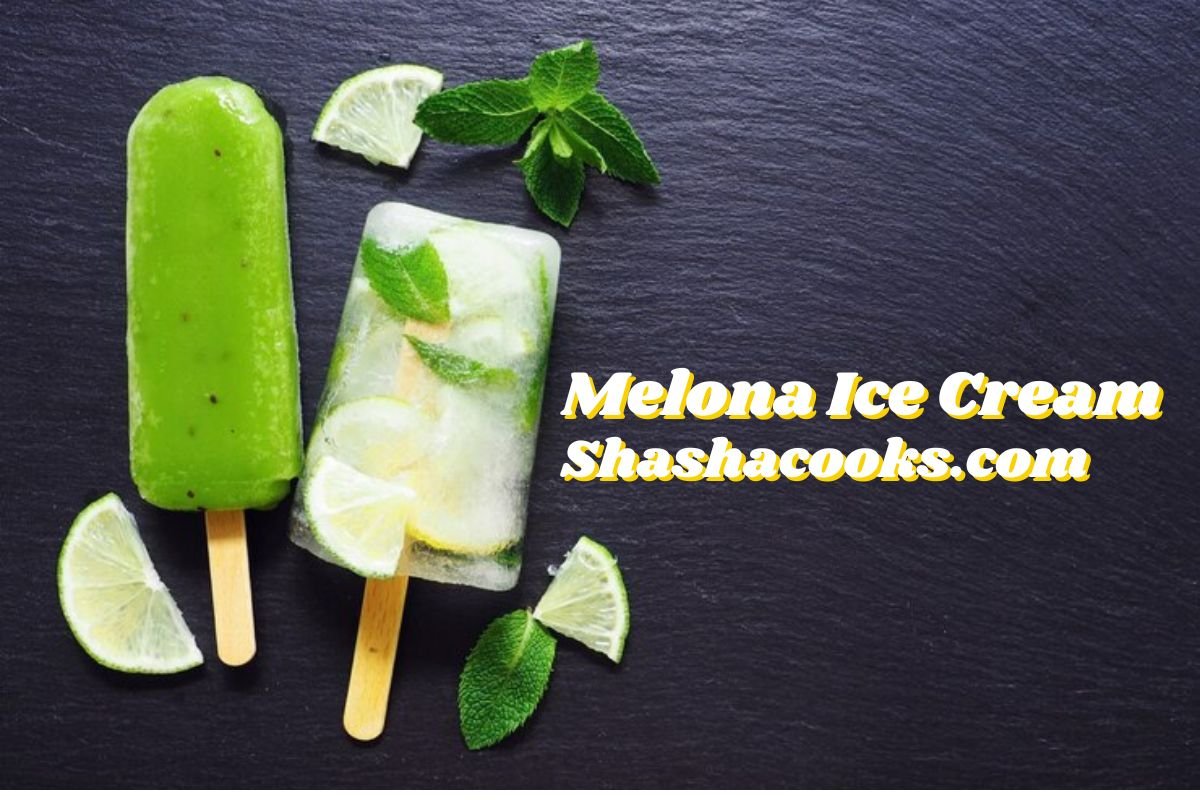FOOD
Melona Ice Cream: A Delicious Korean Dessert Sensation

When it comes to refreshing, unique ice cream treats, Melona has carved out a delicious niche in the world of desserts. Originating from South Korea, this creamy, flavorful ice cream bar has gained a global following, delighting taste buds and cooling off hot summer days. From its vibrant flavors to its smooth texture, Melona offers a distinct and irresistible experience that captures the essence of Asian snacking culture.
What is Melona?
Melona is a creamy, fruit-flavored ice cream bar that hails from South Korea. Known for its pastel-colored appearance and smooth texture, Melona is made with real fruit juice and milk, creating a refreshing treat that balances sweetness with a hint of tanginess. Available in various flavors, Melona has become a staple in many households and a go-to dessert option for those seeking a quick and delightful indulgence.
The Rise of Melona
History and Origins
Melona was first introduced in 1992 by the Korean company Binggrae, known for its wide range of dairy and snack products. The goal was to create an ice cream treat that was not only delicious but also unique in flavor and texture. Since its inception, Melona has steadily grown in popularity, thanks in part to its innovative approach to traditional ice cream flavors.
Introduction to the Global Market
Melona’s popularity transcended South Korean borders, captivating ice cream enthusiasts worldwide. Its entry into international markets was marked by a growing demand for unique Asian desserts. Today, Melona is available in various countries, including the United States, Canada, Australia, and several Asian countries, where it continues to gain a devoted fan base.
Melona Ice Cream
What Makes Melona Unique?
Melona’s allure lies in its perfect blend of flavors, texture, and presentation. Unlike typical ice cream bars, Melona offers a creamy yet refreshing experience that sets it apart from other frozen treats. Its use of real fruit juice gives each flavor an authentic taste, while the creamy base ensures a satisfying melt-in-your-mouth sensation.
Ingredients and Nutritional Information
Melona’s ingredients list is simple yet effective, consisting of milk, sugar, fruit juice or puree, and natural flavorings. Each bar is designed to deliver a rich taste without overwhelming the palate. Despite its indulgent flavor, Melona is relatively low in calories, with most bars containing around 110-130 calories, making it a guilt-free treat for many.
Popular Melona Flavors
Melona offers a range of flavors to cater to diverse tastes. Some of the most popular options include:
- Melon: The original and most iconic flavor, known for its subtle sweetness and authentic melon taste.
- Strawberry: A classic favorite that combines the freshness of strawberries with creamy undertones.
- Banana: A smooth and rich flavor reminiscent of ripe bananas.
- Coconut: For those who enjoy tropical flavors, this option provides a refreshing escape.
- Mango: Bursting with the vibrant taste of mangoes, this flavor is a tropical delight.
Seasonal and Regional Varieties
In addition to its core flavors, Melona occasionally introduces seasonal and regional varieties to keep things exciting. These limited-edition options often showcase unique flavors inspired by local ingredients or popular trends, allowing Melona to stay relevant and enticing to its audience.
The Popularity of Melona
Melona in Pop Culture
Melona’s popularity extends beyond its taste, with appearances in various forms of media and pop culture. It has been featured in Korean dramas, music videos, and social media platforms, further cementing its status as an iconic treat. Its vibrant colors and nostalgic appeal make it a favorite subject for food bloggers and influencers, contributing to its widespread recognition.
Melona’s Global Appeal
The global appeal of Melona can be attributed to its ability to bridge cultures through the universal language of food. Its unique flavors and approachable price point make it an accessible treat for people of all ages and backgrounds. Whether enjoyed as a quick snack or a dessert, Melona offers a taste of Korea that resonates with consumers worldwide.
Melona’s Place in Korean Culture
Traditional Korean Desserts
Korean cuisine is renowned for its diverse range of desserts, from rice cakes and sweet pancakes to shaved ice and fruit-based treats. Melona fits seamlessly into this culinary landscape, offering a modern take on traditional flavors that have been enjoyed for generations. Its popularity reflects a broader trend of incorporating contemporary twists into classic Korean desserts.
How Melona Fits into Korean Cuisine
In Korean cuisine, desserts are often enjoyed as part of a larger meal, providing a sweet contrast to savory dishes. Melona’s refreshing and light profile makes it an ideal choice for cleansing the palate and concluding a meal on a high note. Its fruity flavors align with the Korean appreciation for fresh ingredients, while its creamy texture satisfies a craving for indulgence.
Making Melona at Home
Homemade Melona Recipe
For those who enjoy culinary experimentation, making Melona at home is a fun and rewarding endeavor. Here’s a simple recipe to try:
Ingredients
- 1 cup melon (honeydew or cantaloupe), diced
- 1/2 cup milk
- 1/4 cup heavy cream
- 1/4 cup sugar
- 1 tablespoon lemon juice
Instructions
- Blend the melon, milk, heavy cream, sugar, and lemon juice until smooth.
- Pour the mixture into ice cream molds or popsicle molds.
- Freeze for at least 4 hours or until fully set.
- Enjoy your homemade Melona!
DIY Variations and Tips
Experiment with different fruits to create your own Melona-inspired flavors. Mango, strawberry, and coconut are excellent choices. Adjust the sugar level to your preference, and consider adding a pinch of salt to enhance the overall taste. For a creamier texture, use full-fat dairy products or coconut milk for a dairy-free option.
Where to Buy Melona
Melona in Local Supermarkets
Melona is widely available in Asian supermarkets and grocery stores with an international section. Look for them in the frozen dessert aisle, where they’re typically sold in individual bars or multi-packs. Some larger supermarket chains may also carry Melona, particularly in areas with a significant Asian population.
Online Retailers Offering Melona
For those who prefer the convenience of online shopping, several retailers offer Melona for purchase. Websites such as Amazon, Walmart, and specialty Asian grocery stores often have Melona in stock, with options for delivery to your doorstep. Online purchasing ensures you can enjoy Melona regardless of your location.
The Science Behind the Creamy Texture
Why is Melona So Creamy?
Melona’s creamy texture results from its precise formulation, which balances milk, cream, and fruit juice to achieve the perfect consistency. The combination of ingredients, along with specific production techniques, creates an ice cream bar that is smooth and satisfying. The use of emulsifiers and stabilizers helps maintain this texture throughout the freezing process.
Comparison with Other Ice Cream Brands
Compared to other ice cream brands, Melona stands out for its light yet creamy profile. While traditional ice creams often prioritize richness and decadence, Melona focuses on delivering a refreshing experience that doesn’t sacrifice flavor. Its emphasis on real fruit ingredients further distinguishes it from competitors, offering a more authentic taste.
Health Considerations
Nutritional Profile of Melona
Melona offers a relatively low-calorie dessert option, with most bars containing between 110 and 130 calories. They are lower in fat than many traditional ice creams, making them a more mindful choice for those watching their caloric intake. However, like all desserts, they should be enjoyed in moderation as part of a balanced diet.
Melona vs. Other Ice Creams
When compared to other ice creams, Melona is often praised for its lighter texture and lower calorie content. Traditional ice creams can be high in fat and sugar, while Melona provides a more balanced option. For those seeking a refreshing treat that satisfies without overindulgence, Melona is an appealing choice.
Sustainability and Melona
Melona’s Environmental Impact
As consumers become more environmentally conscious, the sustainability of food products is increasingly important. Melona is committed to minimizing its environmental impact by utilizing sustainable sourcing practices and reducing waste throughout production. These efforts align with broader industry trends towards more responsible consumption.
Packaging Innovations
Melona’s packaging is designed to be both functional and environmentally friendly. Recent innovations focus on reducing plastic waste and increasing recyclability. By prioritizing sustainable packaging solutions, Melona aims to contribute positively to global environmental efforts while continuing to deliver delicious ice cream treats.
Melona in Different Cuisines
Creative Ways to Use Melona in Cooking
Melona’s versatility extends beyond being a standalone dessert. Its flavors can be incorporated into various culinary creations, from milkshakes and smoothies to desserts like parfaits and trifle. The creamy texture and fruity taste of Melona add a unique twist to traditional recipes, providing endless opportunities for creativity in the kitchen.
Fusion Dishes with Melona
Melona’s appeal lies in its adaptability, making it an ideal component for fusion dishes. Combine it with ingredients from other cuisines to create innovative desserts that captivate the senses. Melona milkshakes with a hint of matcha, or Melona-based sorbets with a touch of spicy chili, exemplify how this Korean treat can inspire culinary exploration.
Future of Melona
Trends and Innovations in the Ice Cream Market
The ice cream market is constantly evolving, with new trends and innovations shaping consumer preferences. As consumers seek healthier, more sustainable options, brands like Melona are well-positioned to lead the way with their emphasis on real ingredients and mindful consumption. The future of Melona is bright, with opportunities for expansion and innovation on the horizon.
What’s Next for Melona?
Melona’s journey is just beginning, with potential for further growth and development. Future plans may include the introduction of new flavors, the exploration of vegan or dairy-free options, and continued efforts towards sustainability. As Melona continues to captivate audiences worldwide, its dedication to quality and innovation remains at the forefront.
Also Read: Discover the Recipe Jalbiteworldfood: A Culinary Journey
FAQs
Is Melona vegan?
No, Melona is not vegan, as it contains milk and cream. However, there are dairy-free and vegan ice cream alternatives available for those seeking plant-based options.
How many calories are in a Melona ice cream bar?
A typical Melona ice cream bar contains between 110 and 130 calories, making it a relatively low-calorie dessert option compared to traditional ice creams.
Where is Melona available outside of Korea?
Melona is available in various countries, including the United States, Canada, Australia, and several Asian countries. It can be found in Asian supermarkets, grocery stores, and online retailers.
What is the most popular Melona flavor?
The most popular Melona flavor is the original melon, known for its authentic taste and refreshing qualities. Other popular flavors include strawberry, banana, and mango.
Can Melona be used in desserts other than ice cream?
Yes, Melona can be incorporated into various desserts, such as milkshakes, smoothies, parfaits, and trifle. Its creamy texture and fruity flavors make it a versatile ingredient in culinary creations.
How does Melona maintain its texture during production?
Melona’s creamy texture is achieved through a precise formulation of ingredients, including milk, cream, and fruit juice, along with the use of emulsifiers and stabilizers to maintain consistency during freezing.
Conclusion
The Sweet Success of Melona
Melona has captured the hearts of ice cream lovers worldwide with its delightful flavors, creamy texture, and refreshing qualities. As a beloved Korean dessert, Melona represents the perfect fusion of tradition and innovation, offering a taste experience that transcends borders. With its continued popularity and potential for growth, Melona’s sweet success story is far from over. Whether enjoyed as a quick snack or incorporated into creative culinary creations, Melona is a testament to the joy of discovering new flavors and embracing the world of desserts.
FOOD
The Best Mee Sedap Flavors with Imaginative Recipes to Endeavor

Mee Sedap, generally called Mie Sedaap in Indonesia, has been around beginning around 2003. This notable second noodle brand is the brainchild of WINGS Social occasion Indonesia, and they esteem using top notch trimmings and normal flavors, got together with a faultlessly changed planning itemizing. Mi Sedaap second noodles are available in 30 countries, including Malaysia and Singapore. Expecting you’ve perceived this brand on the walkways of your nearest store and are planning to look at it, read on as we uncover the really 3 Mi Sedaap flavors and proposition a couple of stimulating recipes that will take your second noodle experience to a more elevated level. Anything warm and tasty can offer a sense of delicacy to your tongue while making your mood swings subside. A bowl of chicken noodles ( Mie Sedap) is all you need to calm down and soothe your brain fibers. A good meal can always boost your serotonin because every delicious meal makes both your stomach and soul feel satisfied and good.
Is Mi Sedaap Safeguarded to Eat?
- Without a doubt, Mi Sedaap’s second noodles are safeguarded to eat! They meet different halal and sterilization rules, similar to the ISO 22000 Attestation for Worldwide Standards of Food dealing with The leaders and the ISO 9001 License for Overall Quality Organization System Standards.
- The ISO 22000 Attestation ensures that Mi Sedaap has completed measures to control sterilization risks, while the ISO 9001 Authentication guarantees that the affiliation has spread out compelling cycles and arranged their staff to dependably convey faultless things.
- With these endorsements set up, you can truly believe the security and nature of Mi Sedaap’s second noodles.
Best Mi Sedaap Flavors
In 2003, Mie Sedap made its show with 2 luscious flavor decisions: Mi Sedaap Goreng Asli and Mi Sedaap Soto. From there on out, they have stretched out their scope to integrate a varying assurance of flavors, going from singed noodles (goreng) to soups, offering a wide combination of Asian-stirred flavors to take extraordinary consideration of different tendencies.
Among their expansive goreng decision, our really 3 top picks are the Goreng Asli, Ayam Krispi, and Korean Hot Chicken. All of these flavors offer a fascinating and satisfying taste experience that makes us need to an ever increasing extent.
Mi Goreng Perisa Asli
The Mi Goreng Perisa Asli offers an excellent understanding of Mi Goreng (container burned noodles), updated by the great pound of their interesting Kriuk-Kriuk® seared onions. With an abundance of firm burned onions and thick, chewy noodles, this dish offers a superb surface that supplements the sweet, perfect and red hot notes of the dish.
If you should dial down on the force or add a smooth surface to the dish, top the noodles with a runny splendid side egg and join everything as one going before serving!
Mi Goreng Ayam Krispi
If you love burned chicken, the Mi Goreng Ayam Krispi might be most certainly right up your alley! The springy noodles gloat a tempting aroma and sort of seared chicken. Regardless, that isn’t all – even the crunchy Krezz-Krezz® cooked onion pieces are permeated with the brilliant taste of chicken, ensuring a truly satisfying encounter.
Mi Goreng Korean Searing Chicken
Mi Sedaap’s Korean Fiery Chicken flavor is the ideal choice for those in the disposition for a singing, mouth-watering experience and those expecting to begin to sweat while participating in a tasty banquet! The thick, springy noodles are planned to retain the red hot sauce, giving you a flavourful contribution in each snack.
FOOD
Lobster Love: 7 Simple Christmas Appetizers Starring Fresh Lobster Meat

Lobster is special. It is a fancy food that makes any dish feel extra special. This holiday season, surprise your guests with appetizers made from fresh lobster. Lobster has a rich and sweet flavor. It makes meals taste amazing. Whether you are hosting a party or want to make your Christmas meal fancy, lobster can help. It makes appetizers delicious and memorable. Try making savory lobster rolls. Or make a lobster and crab mini frittatas. These recipes are easy to make and look fantastic. Your loved ones will talk about them for sure. So, let’s explore how to use lobster. Bring joy to your holiday table with these tasty appetizers!
7 Easy and Elegant Lobster Appetizer for your Holiday Gatherings
-
Lobster & Avocado Crostini
It perfectly balances creamy avocado and sweet, succulent lobster on crispy toast.
Ingredients:
- 1 fresh lobster tail, cooked and chopped
- 1 ripe avocado, mashed
- Lemon juice, to taste
- Salt & pepper
- Fresh parsley, chopped
- Baguette, sliced and toasted
Steps:
- In a bowl, mix the mashed avocado, lobster, lemon juice, salt, and pepper.
- Spread the mixture on each toasted baguette slice.
- Garnish with fresh parsley.
- Serve immediately for a light, refreshing bite.
-
Lobster Deviled Eggs
A twist on the classic deviled eggs, filled with the richness of lobster and creamy mustard mayo.
Ingredients:
- 4 boiled eggs, halved
- 1/2 cup lobster meat, finely chopped
- 2 tbsp mayo
- 1 tbsp Dijon mustard
- Lemon zest
- Paprika for garnish
Steps:
- Scoop out the yolks and mash them in a bowl.
- Mix with mayo, mustard, lemon zest, and chopped lobster.
- Pipe or spoon the mixture back into the egg whites.
- Garnish with paprika and serve chilled.
-
Lobster & Spinach Stuffed Mushrooms
Earthy mushrooms stuffed with a luscious lobster and spinach filling, baked to golden perfection.
Ingredients:
- 10 large mushrooms stems removed
- 1/2 cup lobster meat, chopped
- 1/2 cup spinach, sautéed and chopped
- 2 tbsp cream cheese
- 1/4 cup grated parmesan
- Salt and pepper
Steps:
- Preheat the oven to 375°F.
- Mix the lobster, spinach, cream cheese, and parmesan in a bowl. Season with salt and pepper.
- Stuff the mushrooms with the mixture and place on a baking sheet.
- Bake for 15-20 minutes, until golden and bubbly.
-
Lobster Rolls on Mini Brioche Buns
Sweet lobster served in soft, buttery brioche buns, perfect for a Christmas gathering.
Ingredients:
- 1 fresh lobster tail, cooked and chopped
- 2 tbsp mayo
- 1 tbsp lemon juice
- Fresh chives, chopped
- Mini brioche buns
- Salt and pepper to taste
Steps:
- Mix the lobster, mayo, lemon juice, and chives in a bowl. Season with salt and pepper.
- Lightly toast the mini brioche buns.
- Spoon the lobster mixture into the buns and serve as bite-sized delights.
-
Lobster-Coconut Ceviche
A tropical, refreshing ceviche with lobster and coconut that’s perfect for adding a fresh flair to your Christmas appetizer spread.
Ingredients:
- 1/2 lb fresh lobster meat, chopped
- 1/2 cup coconut milk
- 1 lime, juiced
- 1/2 cup diced cucumber
- 1 small red onion, finely chopped
- Fresh cilantro, chopped
- Salt and pepper
Steps:
- Combine the lobster, coconut milk, lime juice, cucumber, onion, and cilantro in a bowl.
- Season with salt and pepper.
- Let it sit in the fridge for at least 30 minutes to allow the flavors to meld.
- Serve chilled with tortilla chips for a refreshing holiday treat.
-
Lobster and Crab Mini Frittatas
Savory, fluffy, and packed with rich seafood flavors, these bite-sized frittatas are easy to make and look impressive on any table.
Ingredients:
- 4 large eggs
- 1/2 cup heavy cream
- 1/2 cup cooked lobster meat (chopped into small pieces)
- 1/2 cup lump crab meat (ensure it’s clean and shell-free)
- 1/4 cup shredded Parmesan cheese
- 1/4 cup sharp cheddar cheese (optional for extra flavor)
- 1 small shallot, finely chopped
- 1 clove garlic, minced
- 2 tablespoons fresh chives, finely chopped (plus extra for garnish)
- Salt and black pepper to taste
- 1 tablespoon olive oil or butter (for cooking shallots and garlic)
- Non-stick spray or butter (for greasing muffin tin)
Steps:
- Preheat your oven to 350°F (175°C). Grease a 12-cup muffin tin with olive oil or melted butter to ensure the frittatas won’t stick.
- Gently fold the lobster meat and crab meat together in a large bowl. Be careful not to break the pieces too much. Set aside.
- Whisk together the eggs, heavy cream (or milk), Parmesan cheese, garlic powder, and a pinch of salt and pepper in a large bowl. Add the fresh chives and red bell pepper (if using) to the mixture. Stir to combine.
- Spoon the lobster and crab mixture evenly into the muffin tin cups. Then, pour the egg mixture over the seafood until each muffin cup is filled but not overflowing.
- Place the muffin tin in the oven and bake for 15-18 minutes, until the frittatas are set in the center and lightly golden on top. A toothpick inserted into the center should come out clean.
- Once baked, allow the mini frittatas to cool for a few minutes before removing them from the muffin tin. Garnish with fresh parsley and serve warm.
Wrap-up
Lobster adds a luxurious and approachable twist to your holiday appetizers. It elevates the flavors of any gathering. You can prepare dishes like a classic lobster roll, stuffed mushrooms, or a lobster and crab mini frittatas. These dishes are easy and impressive. Lobster has a delicate sweetness. It is versatile, meaning it can be used in many different recipes. This makes lobster perfect for making the holiday season extra special. Dive in and let these simple and indulgent dishes bring the warmth of Christmas cheer to your table. Enjoy the love, the laughter, and, of course, the lobster!
FOOD
How Do Wood Pellets Enhance Flavor?

Wood pellets made from shavings and sawdust provide an ideal fuel source for cooking with a pellet fired pizza oven. They have numerous advantages over other fuel sources that affect the pizza’s final flavor. Here are some of the ways that wood pellets can enhance the flavor of pizza:
Temperature Control
Wood pellets reach high temperatures for consistent fuel feeding and aeration. The high heat inside an oven can caramelize the sugars in the pizza dough and toppings. It sears the meat used in pizza toppings to lock in its natural juices within the dough.
A pellet fired pizza oven provides the a more precise way to control temperature for slow or fast cooking. Chefs can load this type of oven with different types of wood to control the oven’s temperature for a better result. Higher temperatures redcue the production of ashes and excess smoke that might alter the taste, while low temperatures enable slow searing.
Wood Type Variety
Pizza makers use different wood pellets for temperature control because of their distinct burn durations. Hardwoods, like oak, generate consistent heat that suits slow food preparation for meat dishes. Softer woods offer lighter and quicker ways to prepare food dishes like vegetables and white meat that do not require high heat.
Wood pellets derived from different trees produce unique aromas and flavors. Pizza chefs who want to accentuate their dishes with a bolder flavor might choose woods like hickory. This is ideal for pizza that incorporates toppings such as pork and lamb meat. Woods like oak help complement the overall pizza profile as it provides a balanced taste for the toppings and base. Businesses that want to create a sweeter profile opt for fruit woods like cherry or applewood.
Another way to enhance the pizza’s flavor is by mixing pellets made from different wood types. Hardwoods like maple often provide subtle flavor changes to the food, while fruit woods enhance the pizza’s sweetness. A good way to match wood types is to use pellets from the same variety, like oak and mesquite hardwoods.
Natural Flavor Enhancement
Wood pellets do not soak up the pizza’s natural flavor or scent, unlike regular fuels that produce excessive smoke when they are burned in ovens. The pellets gradually add the wood’s inherent flavor to the food. This makes wood pellets a favorable alternative for cooking because they suit both meat and vegetarian recipes.
Quick Flavor Release
Wood pellets are a major component of the cooking process of quality pizza because of their rapid flavor release and clean burns. Wood pellets ignite and burn quickly and can easily be added to the cooking process. They tend to burn faster because of their smaller size and generate less substances like ash, which can alter the pizza’s flavor and produce unwanted characteristics.
Buy a Pellet Fired Pizza Oven
A pellet pizza oven enables chefs to control the heat, infuse flavor, and cook faster for numerous pizza types and flavors. Look for a supplier offering various wood pellet types, like hickory, cherry, applewood, and oak. Contact a supplier today to find a model that suits your pizza production needs.
-

 Technology6 months ago
Technology6 months agointernet chicks: A Digital Phenomenon
-

 Recipes7 months ago
Recipes7 months agoCrab Brulee Recipe: A Gourmet Delight
-

 Recipes7 months ago
Recipes7 months agoSmoothie CCL: A Delicious and Nutritious Trend
-

 FOOD7 months ago
FOOD7 months agoÇeciir: A Journey Through Turkish Cuisine
-

 FOOD7 months ago
FOOD7 months agoCornflake Meringue Cookies
-

 FOOD7 months ago
FOOD7 months agoNasi Uduk
-

 Recipes7 months ago
Recipes7 months agoThe Ultimate Bug Juice Camp Drink Recipe for Fun and Flavor
-

 BLOGS7 months ago
BLOGS7 months agoUnveiling the Innovation: BoltBól – Revolutionizing Accessibility and Mobility
